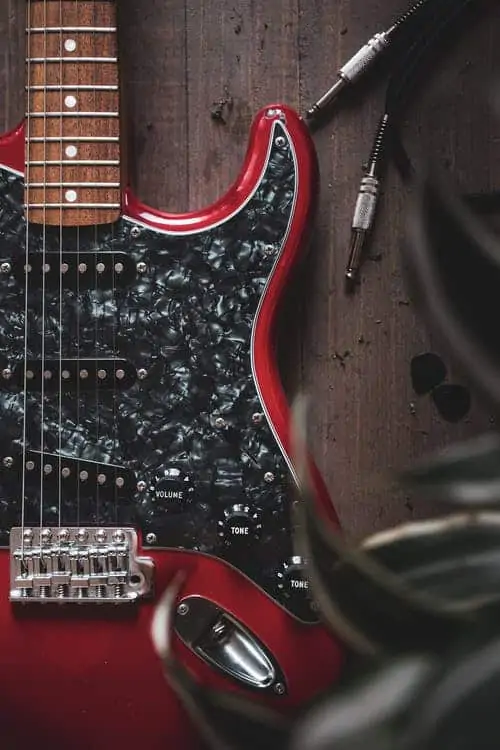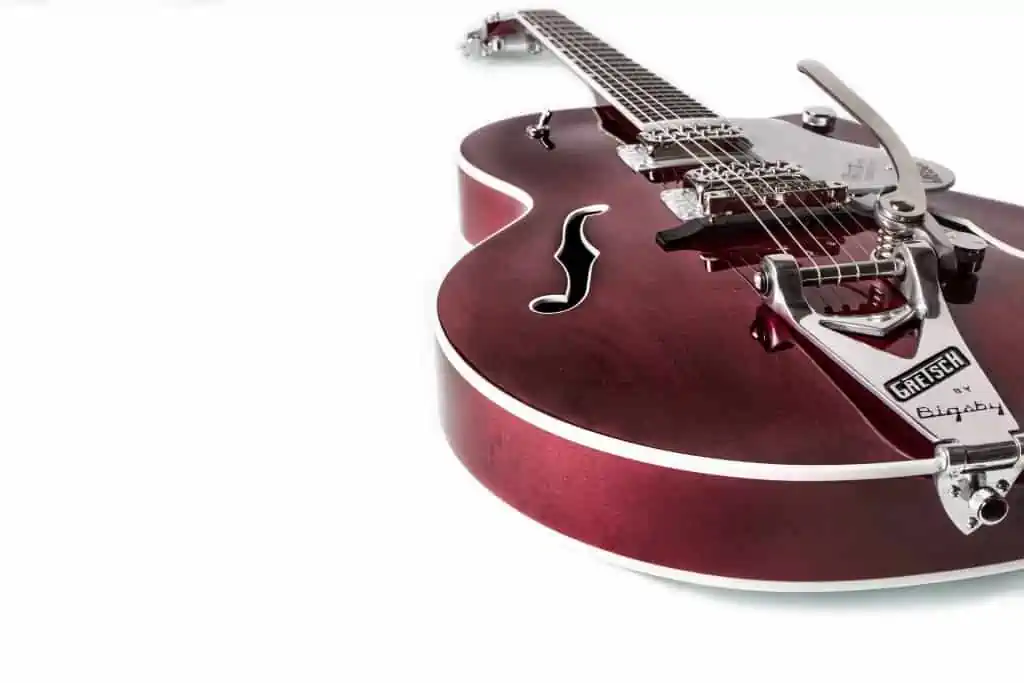If you’re new to the guitar as a whole, you may only be aware of two, maybe three different types of guitars. To think that there are more than 15 different types of guitars, however, seems unreal. As you read on, we will cover 15 of these different guitars you should know about, so that you are aware of other options on the market which may improve your playing experience. Let’s dive in!
Contents
1. Acoustic Guitar
The instrument many beginners have started out on is the acoustic guitar. Widely known for its rich warm tones to its bright and crisp timbres, anyone who knows about the guitar has at least seen one of these. However, what some people might not know is that the standard steel-string acoustic guitar can also come in an electric acoustic steel-string guitar form as well. There aren’t really any differences between the electric and non-electric forms other than the pickups. These pickups can either be Piezo, Magnetic, or Microphone pickups.
Piezo Pickup: The most common pickup used by acoustic guitars, is also known as a transducer pickup. These pickups contain a piezo crystal, which allows the vibrations on the string to be converted to a signal that can therefore be amplified. When hooked into the amplifier, the tone, unlike other pickups, is not generated from the body of the guitar, but solely from the strings. This gives you two different sounds when it’s hooked in versus when it’s not hooked into the amplifier. One with a stronger attack, while the other contains more natural resonance.
Magnetic Pickup: This type of pickup appears as a copper wire that’s wrapped around a magnet. These are the same magnetic pickups found on the electric guitar, creating a magnetic field, which will register the sounds of a steel or nickel-stringed guitar when played. When the instrument is hooked into an amplifier, the sound gets amplified and tends to have more electric/distorted qualities to it.
Microphone Pickup: This is when there’s a small microphone inside of the body of the guitar. This will give you the most accurate representation of your guitar while being able to increase its volume level. One downside, however, is potential feedback compared to the aforementioned pickups.
Both the acoustic steel-string guitar and its non-electric form share a lot of versatility in the genres they are used in. They are generally very good for beginners to start out on, however, due to the nature of their steel strings, your fingers may get sore after short periods of playtime. However, after enough practice, your fingers will develop calluses on the tips making it much more bearable. Its crisp and clear tones will help you detect errors in your playing and allow you to make the appropriate corrections. While the electric guitar has a ton of appeal, the acoustic guitar does deserve a lot of love, and over time that will grow as you continue to play it.
2. Electric Guitar
This glorious guitar is one that everybody should know. Rock concerts are incomplete without them. The electric guitar has evolved much over the course of years since it was invented back in 1931 when it was primarily used by jazz musicians. These guitars often have a flashy appearance with really iconic designs, however, their bodies don’t have any impact on their sound, much the way that the acoustic, or classical guitars do.
Electric guitars typically use the 50/50 blend of steel and steel with nickel plating. From amongst these strings, there are bundles you can purchase of different thicknesses. These different packs contain groupings of thin, medium, thick and hybrid strings.
Thin strings usually consist of thicknesses of: .009, .011, .016, .024, .032, and .042. You might use these if you’re a beginner as they aren’t as harsh and painful on the fingers. As for tonal qualities they are typically bright and thin sounding.
Medium strings on the other hand consist of thicknesses: .010, .013, .017, .026, .036, .046. These are the average strings someone would use on their electric guitar. You get a nice blend between high-end, and thicker lower-end frequencies. Much like your steel-string acoustic guitar, these contain a like warm resonance in the strings. However, due to their thickness, may not be suitable for beginners, unless they are patient and willing to cope with the soreness.
Thick strings typically have thicknesses of: 0.11, 0.15, .022, .030, .042, .054. These strings when plucked contain a lot of resonance and warmth. Within the genres of rock, metal, and blues, these are fairly common and sound particularly nice in dropped tunings.
Hybrid strings are the best of both worlds, with thicknesses of: .010, .013, .017, .028, .038, .048. You have your higher strings, which carry the brighter tones of the medium strings, as well as the lower more resonant tones of the thick strings. This is the most flexible choice of the options listed here.
As mentioned earlier, pickups are used for electric guitars to allow the signals to be received from an output source, which results in it being amplified. The electric guitar uses its own pickups, such as the single coil, humbucker, and the P90.
Single coil pickups generally produce the brightest tones on the pickups listed here and are excellent in a multitude of genres of music.
Humbucker pickups are basically what you would get if you put two single coil pickups together. These pickups handle distortion great and are really suited for the hard rock and metal genres of music. A downside to these, however, is the lingering electrical humming sound you will hear from your amplifier when you aren’t playing anything.
P90 pickups are to pickups, what the hybrid strings are to guitar strings. You get the best of both worlds, as these contain some of the best parts of your single coil and humbucker pickups. You get the higher output, which makes up for what a single coil pickup lacks, and it handles distortion to an okay extent. Not generally the best at anything, but pretty decent in both respects.
3. Classical Guitar
A classical guitar, being played in a traditional posture, showcasing the nylon strings.
The classical guitar is a popular choice amongst fingerstyle musicians. A modern classical guitar will typically use nylon, or carbon strings, as it cannot handle steel strings. The nylon strings are very soft on the fingers, which makes this guitar an excellent choice for beginners. It has a very warm and mellow sound to it, however, it lacks the certain brightness that the steel-string acoustic can produce.
Being an instrument excellent for fingerstyle guitar, it’s a perfect choice for classical music, flamenco, and other European styles of music. The birth of modern classical guitars goes way back to the late 19th century in Spain, invented by Antonio de Torres. Since it was birthed, these have become something of a standard as far as traditional instruments go.
4. Fretless Guitar
This guitar is exactly as it sounds, not containing a single fret on the neck of the guitar. This makes it extremely challenging for beginners, so it’s highly recommended you have some experience with a regular fretted guitar, be that acoustic, classical, or electric before attempting to play one of these.
Your typical fretted guitar will have 12 frets per octave. What makes the fretless guitar its own animal is that you don’t just have your semitones, as the regular fretted guitar has, but you have your microtones. Microtones, in a nutshell, are notes that aren’t quite tones, and aren’t quite semitones, but somewhere in between that space. Naturally, if you wanted to play one of these on the fretted guitar, you would have to change the tuning, or perhaps bend the string a certain way.
With these guitars, you can often expect a rich and organic tone. Being fretless, you get to experience the guitar in a new light. They are difficult to master, however, with enough time and getting used to where the frets are to be expected, it can be done!
5. Travel Guitar
As you can likely tell, these guitars are compact and great for travel. They offer you the option to have a full-sized fretboard, or something smaller. Travel guitars also come in acoustic and electric forms, so it’s highly recommended to use the one you enjoy playing more.
Now, as the name suggests, these are intended for traveling purposes. It does not have the volume and tonal qualities of a regular acoustic or electric guitar. You may also risk losing it, damaging it, as well as extra luggage costs if you decide to travel with it. It is excellent to have, however, if you intend to practice in a space like a hotel room, where a normal guitar would typically disturb others.
6. Hybrid Guitar
Much like the acoustic steel-string electric guitar, the hybrid guitar is an electric guitar that shares a lot of tonal characteristics, utilizing many of the same pickups. You’ll find that they typically favor the piezoelectric pickup, however, they also make use of the magnetic pickup to give it those sought-after electric guitar qualities. This allows the user to go from something sounding powerful to something warm and rich.
This can be a happy medium for musicians who enjoy the acoustic guitar but want more power and fullness behind it.
7. Resonator Guitar
This is a different kind of acoustic guitar, that contains a resonator, hence the name. The metal cone-shaped resonator is planted inside the guitar’s body, much like the soundhole found on your typical acoustic guitar. The way these resonator guitars work is it when you play a note or a chord, the vibrations will travel from the strings, then go through the bridge and reach the resonator. Ultimately, this is what gives the resonator guitar a brighter tone.
8. Archtop Guitar
An archtop guitar laying flat, showcasing the iconic “f-hole” on the body.
The archetype guitar was invented by a man named Orville Gibson in the 1890s. This type of guitar gets its name from its arched top, but also contains an arched back and often features the iconic “f-hole” you see on violins. You’ll find that this guitar is widely popular amongst blues and jazz guitarists and it can come either come in semi-acoustic or hollow electric form, both of which use steel strings. It has a pretty mellow tone and gets a fair bit of volume.
9. Twelve-String Guitar
Just as this guitar sounds, it does in fact have 12 strings. You’ll notice that the headstock will contain 6 tuning pegs on either side, bringing to question, “what is the standard tuning for a twelve-string guitar?”. It’s not so different from a normal six-string guitar, as it follows the EADGBE tuning, but slightly different. A twelve-string guitar uses EEAADDGGBBEE tuning, but for the second low E, A, D, and G strings instead are raised by a whole octave, while the second B and high E strings are in unison with the first.
Ultimately, the twelve-string guitar when played gives you a very unique chorus effect, this is caused by the strings vibrating “out of phase” with one another, as they can’t be played with simultaneous precision.
Twelve-string guitars, particularly their headstock, neck, and body are naturally built to be more durable to handle the tension of the strings. These guitars may be used in both acoustic, and electric guitar forms, however, acoustic is the more common variation.
10. Harp Guitar
If you think about your standard six-string guitar, a harp guitar has the same general concept except for additional open strings above the low E string. These additional open strings are what give the harp guitar its name.
You can find this kind of guitar in either acoustic or electric guitar form, however, you’ll find that the acoustic variation is more commonly used. These harp guitars also come in more variations in regards to the “harp addition”, where they may include more bass strings, hollow arms, or double necks.
In terms of sound, a harp guitar can provide a more full sound, as in a way, it’s like strapping a bass guitar to a standard guitar. For fingerstyle musicians, this can really take their music to the next level. Modern harp guitars will typically have an input for the guitar strings, and a separate one for the harp addition, allowing you to really customize the sound to your liking.
11. Touch Guitar
If you enjoy tapping on the fretboard of the guitar, then chances are that the touch guitar might be up your alley. The soul purpose of this guitar is to be tapped or touched, and not plucked or strummed.
Touch guitars have two necks, one for the guitar in its standard tuning, and the other for the bass in its standard tuning. These guitars, unlike your standard guitar, can only produce a sound when you touch or pick the string. When the string is released, the sound is muted, eliminating the need for you to mute the strings manually.
These guitars also happen to be very versatile in tones they can produce, making them an excellent choice for an array of musical genres.
12. Steel Guitar
A steel guitar is being played on the lap of the musician while he uses a slider.
These can often be referred to as two separate things, the first we’ll talk about is the kind of guitar meant to be placed on your lap, or stand. You’ll often hear these used in country music, as that high pitch sliding noise in the background, giving the music a true western vibe. This is achieved by using a slide, which looks like a steel cylinder that goes around the guitarist’s index finger on their fretting hand.
Here is but one example of the steel guitar and slide in action:
The second method of steel guitar playing involves taking an average guitar and playing it in “steel guitar fashion”. Which, in this case, will often be placed on the guitarist’s lap, or on a flat surface. If you’ve seen the movie “August Rush”, you may be aware of what famous scene I’m referencing.
13. Baritone Guitar
This six-stringed guitar goes about a perfect 4th below the standard tuning of a normal guitar. Naturally, these guitars are bigger and longer in size with heavier internal bracing to accommodate their lower tuning. These guitars are iconic for being played in classic spaghetti western, country, and surf music.
14. Extended Range Guitar
Guitars that are referred to as “extended range” can imply a couple of different things:
- Contains more than six strings.
- Lower tuning, resulting in longer scale length.
If your extended range guitar has strings beyond the sixth, perhaps a seventh, eighth, or ninth, then your tunings for these strings would be B, F#, and C#. This can really open up some possibilities for you on the guitar. You can make new chords and shapes, and get creative with arpeggios, scales, and even different tunings. The world is your oyster.
This, however, might not be ideal for beginners, as it has a wider fretboard which may take some time and practice to get used to. If you struggle with forming chords, this will make it all the more difficult.
The baritone guitar mentioned prior, could under these specifications be classified as extended range, given its lower tuning and longer scale length. However, to keep things simple, we’ll leave it at the additional strings.
15. Quad Guitar
We’ve saved the best for last, the quad guitar. This beast of a guitar has four necks, the top two having seven strings, while the bottom two have six. It takes a very skilled musician to play one of these, so they are very niche. The necks all serve a similar purpose, to harmonize with one another, and are done so by being played on multiple necks at once.
This is kind of a wild instrument to look at. Of course, this guitar was invented to be a visually stunning instrument, especially live, with each neck pointing outward diagonally. It is, however, still a playable instrument in its own right.
Shopping For Different Guitars
The inside of a music store that is displaying all of the different guitar options to choose from.
Now that we’ve covered 15 different types of guitars, let’s briefly take a look into what you should look for when shopping for a new one. Generally, this can come down to a few things, such as its shape, versatility, and make.
In regards to shape, this doesn’t have much of an impact on an electric guitar, unless you want something that feels a particular way when you hold it. For an acoustic guitar, the shape will matter a great deal as this will impact how it sounds.
When we talk about versatility, what’s implied here is what the guitar is capable of doing, and how it may be used in different situations. Some of the guitars mentioned prior will have additional functions not found on your typical guitar, while for others it may just come down to the variety of tones they can produce.
Finally, we have “the make” of the guitar. There are many different guitar brands you might choose to go with, each with its own pros and cons. For instance, Yamaha guitars are excellent and affordable for beginners, but for many of the lower-end models, this is at the cost of sound quality. You also have Fender, which is an iconic brand for guitars, and it pretty much always has been. A lot of high-quality guitars have come from Fender, such as the very iconic Fender Stratocaster. However, most of what you’re paying for is the brand, as you can get the same, if not higher quality elsewhere for the same budget.
Now, these were only some of the things to look out for, however, there are more things you should consider. For instance, does the guitar stay in tune very well? How comfortable is the fretboard? Is the neck of the guitar straight? When shopping for guitars it’s highly recommended to be there in person and try out these various aspects. The last thing you would want as a guitarist, or aspiring musician is to buy an instrument you don’t enjoy playing.
Conclusion
Now you know a little more about the vast world of guitars. It’s really interesting to see how far they have come over the years, and very exciting to think about how much further they can go as technology advances. If you had your choice, what guitar would you aim to learn? What style of music would you make with it? The possibilities are endless.






